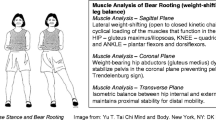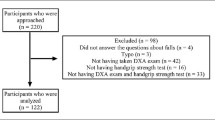Abstract
Falls and associated injuries are the most serious medical problem affecting the functional independence among both White non-Hispanics and Latino older adults. Studies have shown the effectiveness of Tai Chi exercise in reducing falls but have primarily focused on White non-Hispanic older adults. There is limited research that examines the effectiveness of this exercise on balance among different racial/ethnic minority older adults. This study focused on the interrelationship between functional status (balance performance) and psychosocial status (depression) before and after a 12-week Tai Chi program among Latinos in a Midwestern metropolitan city. Results indicated that at baseline, prior to the start of the Tai Chi program, participants who were more depressed had poorer functional status. Participants who had higher depression at baseline, experienced greater improvement in functional status, following the 12-week Tai Chi exercise program, compared with those who had lower levels of depression.





Similar content being viewed by others
References
Patil R, Uusi-Rasi K, Tokola K et al (2015) Effects of a multimodal exercise program on physical function, falls, and injuries in older women: a 2-year community-based, randomized controlled trial. J Am Geriatr Soc 63:1306–1313. doi:10.1111/jgs.13489
Prudham D, Evans JG (1981) Factors associated with falls in the elderly: a community study. Age Ageing 10:141–146. doi:10.1093/ageing/10.3.141
Lamb K, Miller J, Hernandez M (1987) Falls in the elderly: causes and prevention. Orthop Nurs 6:45–49
Sattin RW (1992) Falls among older persons: a public health perspective. Annu Rev Public Health 13:489–508. doi:10.1146/annurev.pu.13.050192.002421
Gillespie LD, Robertson MC, Gillespie WJ et al (2012) Interventions for preventing falls in older people living in the community. Cochrane Database Syst Rev 9:CD007146. doi:10.1002/14651858.CD007146.pub3
Centers for Disease Control and Prevention, National Center for Injury Prevention and Control. Web-based injury statistics query and reporting system (WISQARS). http://www.cdc.gov/injury/wisqars/. Accessed 31 May 2016
Wilson MMG, Miller DK, Andresen EM et al (2005) Fear of falling and related activity restriction among middle-aged African Americans. J Gerontol 60:355–360. doi:10.1093/gerona/60.3.355
Stevens JA, Corso PS, Finkelstein EA et al (2006) The costs of fatal and non-fatal falls among older adults. Inj Prev 12:290–295. doi:10.1136/ip.2005.011015
Stevens JA, Mack KA, Paulozzi LJ et al (2008) Self-reported falls and fall-related injuries among persons aged ≥65 years—United States, 2006. J Saf Res 39:345–349. doi:10.1016/j.jsr.2008.05.002
Li JX, Hong Y, Chan K et al (2001) Tai chi: physiological characteristics and beneficial effects on health. Br J Sports Med 35:148–156
Wu G (2002) Evaluation of the effectiveness of Tai Chi for improving balance and preventing falls in the older population—a review. J Am Geriatr Soc 50:746–754. doi:10.1136/bjsm.35.3.148
Low S, Ang LW, Goh KS et al (2009) A systematic review of the effectiveness of Tai Chi on fall reduction among the elderly. Arch Gerontol Geriatr 48:325–331. doi:10.1016/j.archger.2008.02.018
Li F, Harmer P, Glasgow R et al (2008) Translation of an effective Tai Chi intervention into a community-based falls prevention program. Am J Public Health 98:1195–1198. doi:10.2105/AJPH.2007.120402
Mossey JM (1985) Social and psychologic factors related to falls among the elderly. Clin Geriatr Med 1:541–553
Whooley MA, Kip KE, Cauley JA et al (1999) Depression, falls, and risk of fracture in older women. Study of Osteoporotic Fractures Research Group. Arch Intern Med 159:484–490. doi:10.1001/archinte.159.5.484
Means KM, O’Sullivan PS, Rodell DE (2003) Psychosocial effects of an exercise program in older persons who fall. J Rehabil Res Dev 40:49–58
Pratt LA, Brody DJ (2008) Depression in the United States household population, 2005–2006. NCHS Data Brief 7:1–8
Kvelde T, McVeigh C, Toson B et al (2013) Depressive symptomatology as a risk factor for falls in older people: systematic review and meta-analysis. J Am Geriatr Soc 61:694–706. doi:10.1111/jgs.12209
Huang FY, Chung H, Kroenke K, Spitzer RL (2006) Racial and ethnic differences in the relationship between depression severity and functional status. Psychiatr Serv 57:498–503
Siu KC, Rajaram S, Padilla C (2015) Impact of psychosocial factors on functional improvement in Latino elderly after Tai Chi exercise. J Aging Phys Act 23:120–127. doi:10.1123/japa.2013-0164
Passel JS, Cohn D (2009) A Portrait of Unauthorized Immigrants in the United States. Pew Hispanic Center, Washington, DC
Department of Health and Human Service, Administration on Aging (2010). http://www.aoa.gov. Accessed 31 May 2016
Center for Disease Control (2013) CDC health disparities and inequalities report—United States. Morb Mortal Wkly Rep Suppl 62:1–184. http://www.cdc.gov/mmwr/pdf/other/su6203.pdf. Accessed 31 May 2016
Black SA, Markides KS, Miller TQ (1998) Correlates of depressive symptomatology among older community-dwelling Mexican Americans: the Hispanic EPESE. J Gerontol B Psychol Sci Soc Sci 53:S198–S208. doi:10.1093/geronb/53B.4.S198
Hernandez R, Prohaska TR, Wang PC, Sarkisian CA (2013) The longitudinal relationship between depression and walking behavior in older Latinos: the “!Caminemos!” Study. J Aging Health 25:319–341. doi:10.1177/0898264312468488
Alegría M, Canino G, Ríos R et al (2002) Mental health care for Latinos: inequalities in use of specialty mental health services among Latinos, African Americans, and non-Latino Whites. Psychiatr Serv 53:1547–1555. doi:10.1176/appi.ps.53.12.1547
Robins LN, Locke BZ, Regier DA (1991) An overview of psychiatric disorders in America. In: Robins LN, Regier DA (eds) Psychiatric disorders in America: the Epidemiologic Catchment Area Study. Free Press, New York
Unützer J, Katon W, Callahan CM et al (2003) Depression treatment in a sample of 1,801 depressed older adults in primary care. J Am Geriatr Soc 51:505–514. doi:10.1046/j.1532-5415.2003.51159.x
Hong Y, Li JX, Robinson PD (2000) Balance control, flexibility, and cardiorespiratory fitness among older Tai Chi practitioners. Br J Sports Med 34(1):29–34. doi:10.1136/bjsm.34.1.29
Berg KO, Wood-Dauphinee SL, Williams JI et al (1989) Measuring balance in the elderly: preliminary development of an instrument. Physiother Can 41:304–311
Shumway-Cook A, Gruber W, Baldwin M et al (1997) The effect of multidimensional exercises on balance, mobility, and fall risk in community-dwelling older adults. Phys Ther 77:46–57
Shumway-Cook A, Brauer S, Woollacott M (2000) Predicting the probability for falls in community-dwelling older adults using the timed up & go test. Phys Ther 80:896–903
Andresen EM, Malmgren JA, Carter WB et al (1994) Screening for depression in well older adults: evaluation of a short form of the CES-D (Center for Epidemiologic Studies Depression Scale). Am J Prev Med 10:77–84
Ruiz-Grosso P, de Mola CL, Vega-Dienstmaier JM et al (2012) Validation of the Spanish Center for Epidemiological Studies Depression and Self-Rating Depression Scales: a Comparative Validation Study. PLoS One 7:e45413. doi:10.1371/journal.pone.0045413
Williams JS, Kowal P, Hestekin H et al (2015) Prevalence, risk factors and disability associated with fall-related injury in older adults in low- and middle-income countries: results from the WHO Study on global AGEing and adult health (SAGE). BMC Med 13:147. doi:10.1186/s12916-015-0390-8
Kvelde T, McVeigh C, Toson B et al (2013) Depressive symptomatology as a risk factor for falls in older people: systematic review and meta-analysis. J Am Geriatr Soc 61:694–706. doi:10.1111/jgs.12209
Patten CA, Vickers KS, Martin JE et al (2003) Exercise interventions for smokers with a history of alcoholism: exercise adherence rates and effect of depression on adherence. Addict Behav 28:657–667. doi:10.1016/S0306-4603(01)00280-5
Rantakokko M, Pakkala I, Äyräväinen I et al (2015) The effect of out-of-home activity intervention delivered by volunteers on depressive symptoms among older people with severe mobility limitations: a randomized controlled trial. Aging Ment Health 19:231–238. doi:10.1080/13607863.2014.924092
Martínez N, Martorell C, Espinosa L et al (2015) Impact of Qigong on quality of life, pain and depressive symptoms in older adults admitted to an intermediate care rehabilitation unit: a randomized controlled trial. Aging Clin Exp Res 27:125–130
Flores WV, Benmayor R (2004) Latino cultural citizenship: claiming identity, space, and rights. Beacon Press, Boston
Acknowledgments
The project was approved by our insitutional review board (IRB# 454-11-EP) and supported by the Mutual Fund from the College of Public Health at University of Nebraska Medical Center. Authors would like to thank the two Hispanic Tai Chi Instructors, Ms. Teresita Ayala and Ms. Ilda Vazqves, for teaching the Tai Chi program, and the student researcher, Kelsey Wilhelm, for data collection at the Intercultural Senior Center. We would also thank Ms. Teresa Hartman to provide comments on this manuscript.
Author information
Authors and Affiliations
Corresponding author
Ethics declarations
Conflict of interest
On behalf of all authors, the corresponding author states that there is no conflict of interest.
Statement of human and animal rights
All procedures performed in this project involving human participants were in accordance with the ethical standards of our institutional review board and with the 1964 Helsinki declaration and its later amendments or comparable ethical standards.
Informed consent
Informed consent was obtained from all individual participants included in this study.
Rights and permissions
About this article
Cite this article
Siu, KC., Padilla, C. & Rajaram, S.S. The interrelationship between balance, Tai Chi and depression in Latino older adults. Aging Clin Exp Res 29, 395–401 (2017). https://doi.org/10.1007/s40520-016-0593-7
Received:
Accepted:
Published:
Issue Date:
DOI: https://doi.org/10.1007/s40520-016-0593-7




